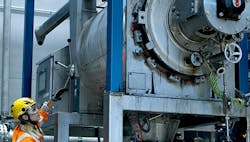Electric Reactor Promises Lower Emissions
Significant reductions in carbon dioxide emissions could come from using electricity instead of fossil fuels to heat reactors in chemical processes that require high temperatures, for example natural gas reforming, say scientists at research, technology, and innovation organization VTT, Espoo, Finland. The electrification of that process alone would markedly decrease global industrial CO2 emissions, they note.
VTT is carrying out work on such reactor heating as part of its iBEX program that looks for novel ways to carry out applied research and develop radical technologies to commercialize them.
Research on the E-Reactor project began in 2020 with an initial survey on potential power sources, for example resistive and induction heating.
“The main challenges have been related to resistive material development,” explains VTT researcher Tomi Lindroos.
While the principle is the same as with electrical resistance heating, applying it to very high temperatures and in conditions where chemical reactions are catalyzed is a new application. At the same time, for commercial viability, the E-Reactor also must suit scaling to industrial capacities, which means electricity use in the range of dozens of megawatts.
The lab-scale E-Reactor currently is working at a 2–4-L/min gas flow rate; Lindroos expects this could be scaled-up ten-fold by the end of 2021.
The first target is the reverse water gas shift reaction; the Finnish researchers also plan to investigate other potential applications as the project progresses.
The materials and catalysts used still are under development, with several patent applications lodged already, so process information remains guarded, explains Lindroos.
Besides scaling-up the E-Reactor, the scientists are eager to perform a long-term trial. “This is due to start late this year at the bench scale to test material stability,” says Lindroos. “The overall efficiency of the process is of great interest here, too,” he notes.
If this work goes well, VTT will decide about scaling-up to demonstration capacity in 2022. “The main challenges here are most likely related to materials and efficiency,” emphasizes Lindroos.
The E-Reactor already has attracted strong industrial interest, he reveals, adding that decisions on any follow-up plans such as investment will be made after the long-term testing phase.
